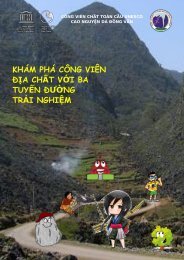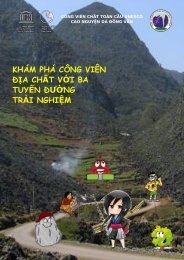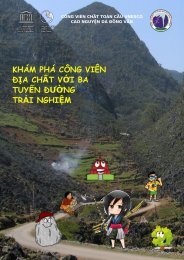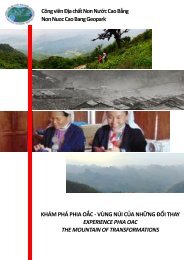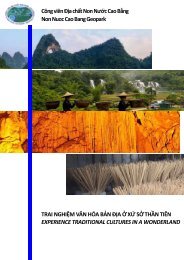Create successful ePaper yourself
Turn your PDF publications into a flip-book with our unique Google optimized e-Paper software.
The North route<br />
9<br />
Serenge plains panorama<br />
Great view of the Serenge plain located at the NW & N of<br />
this observaon point. To the NW view is the Olbalbal<br />
swamp which accumulates water drained from Olduvai<br />
Gorge hills, Ndutu and Serenge areas by gravity scheme.<br />
The Serenge Plain forms the graben part of the Eastern limb<br />
of East Africa Ri Valley.<br />
10<br />
Olduvai gorges and Museum<br />
© www.coolgeography.co.uk<br />
Olduvai Gorge is the most famous archaeological locaon in<br />
East Africa and is from 1979 a World Heritage Site.<br />
Some 30,000 years ago, spling of the earth's surface by<br />
violent geological acvity and millennial of erosion by<br />
seasonally flowing streams incised the nearly 250 foot (90m)<br />
canyon known as Olduvai Gorge. These natural forces<br />
exposed a remarkably rich geological chronicle of human<br />
ancestry and the evoluon of the Serenge ecosystem. It<br />
was here that Mary and Louis Leakey unearthed the first<br />
well-dated arfacts and fossils of some of our earliest human<br />
ancestors aer over 30 years of painstaking work.<br />
These include the famous Zinjanthropus (Australopithecus<br />
boisei) skull, homo habills, the presumed maker of the<br />
numerous early stone tools in the 1.8 to 1.6 million year-old<br />
deposits, and homo erectus, the larger bodied, larger<br />
brained hominin that preceded the earliest modern humans<br />
(Homo sapiens).<br />
Memorial of the Zinjanthropus discovery<br />
The excavaon sites have been preserved for public viewing<br />
and work connues during the dry seasons, coordinated by<br />
the Department of Anquies. One may visit Oldupai at all<br />
mes of the year. It is necessary to have official guide to visit<br />
the excavaons. At the top of the Gorge there is a new<br />
museum developed by the Geopark, a shelte<strong>red</strong> area used<br />
for lectures and talks, toilets, shop of local product,<br />
restaurant and a community center.<br />
©hp://mgafrica.com<br />
What Africa will look like...in about 50 million years!<br />
A pedagogic path (1 hour approximavely) invit to discover,<br />
inside the gorges, the main historical locaons related with<br />
gorges history.<br />
12<br />
©wikimedia commons<br />
The new museum under construcon



